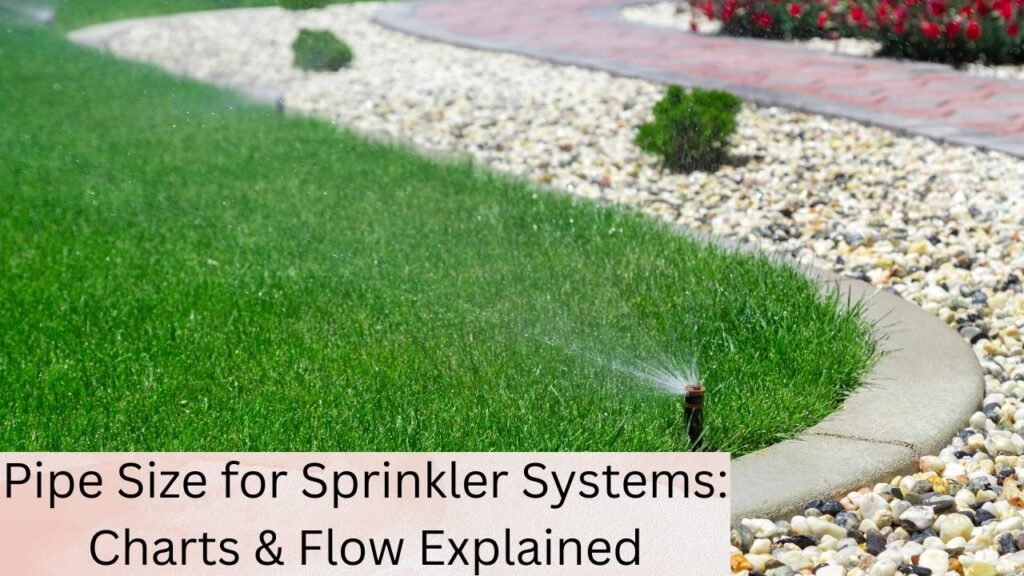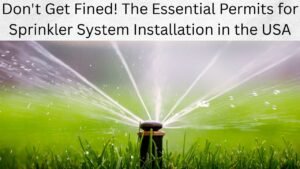Introduction: The Secret to a Lush Lawn Starts with Proper Pipe Size
Tired of dry patches and uneven watering? The secret to a lush lawn lies beneath the surface – in correctly sized sprinkler pipes. A well-designed system ensures uniform watering, saving water, energy, and ultimately, your plants. But how do you know what pipe size is right for your lawn?
Understanding and correctly using sprinkler pipe size charts is the key to achieving optimal performance, and we’ll guide you through exactly how to do that. By the end of this guide, you’ll know how to choose the right pipe size for your system, understand how flow dynamics work, and make sure your sprinkler system delivers efficient, effective watering.

I. Understanding Pipe Size in Sprinkler Systems
Imagine trying to water your garden with a tiny garden hose compared to a wide fire hose. The narrow hose struggles to deliver water, while the wider fire hose can send a larger volume with ease. This concept applies directly to your sprinkler system – the wider the pipe, the more water can flow with less resistance.
If you have undersized pipes, the water flow will be restricted. This can lead to weak, ineffective spray that leaves parts of your lawn dry and thirsty, defeating the purpose of your sprinkler system.
II. How to Read Sprinkler Pipe Size Charts
Reading a sprinkler pipe size chart might sound daunting, but once you get the hang of it, you’ll see how simple it is. These charts help you match your system’s flow requirements to the correct pipe size.
Here’s how you can read a typical chart:
- Find your required flow rate (GPM) – this is how much water your system needs per minute.
- Locate the pipe size that corresponds to that flow rate.
For example, imagine you need to water a flower bed that requires 8 GPM, and the longest pipe run is 75 feet. Consulting a ¾” PVC pipe chart, you would locate the 8 GPM flow rate and see a corresponding friction loss of, say, 1.5 psi per 100 feet and a velocity of 3.5 FPS. This tells you that a ¾” pipe should work well for this scenario, assuming your available pressure can handle the load.
These essential charts are available on the websites of major irrigation system manufacturers (such as Rain Bird, Hunter, Toro), from irrigation supply stores, or within product manuals.
III. Water Flow Fundamentals: Flow Rate, Pressure, and Friction Loss
Ever notice some sprinklers spraying weakly while others are strong? This often boils down to the interplay of flow rate, pressure, and the unseen culprit: friction loss. To simplify, think of it like pushing more water through the same size pipe – it requires more pressure.
- Flow rate is how much water is delivered.
- Pressure is the force pushing that water through the system.
- Friction loss occurs when water moves through pipes and faces resistance – the longer the pipe, the greater the friction.
Higher friction losses can reduce the available pressure at the sprinkler heads, leading to poor performance. Ensuring proper flow rate and pressure is vital to keeping your sprinkler system running smoothly.
IV. Factors That Influence Pipe Size Selection
When choosing the right pipe size for your system, several key factors influence your decision:
- Pipe Run Distance: Longer runs of pipe increase friction loss, requiring larger pipes to ensure adequate pressure and flow at the sprinkler heads.
- Available Water Pressure: If your water pressure is low to begin with, larger pipes may be needed to avoid excessive pressure drops.
- Flow Requirements: The amount of water your sprinkler heads need directly impacts the pipe size. Larger flow demands call for larger pipes.
- Sprinkler Head Type: Some sprinkler heads require more water than others. Be sure to match the pipe size with the sprinkler’s flow requirements.
V. Step-by-Step Guide to Sizing Sprinkler Pipes
Let’s walk through the process of selecting the right pipe size for your sprinkler system:
- Calculate Your Zone’s Thirst: Determine the total GPM needed by all the sprinkler heads in a zone. This will tell you how much water your system needs to deliver.
- Measure Your Pipe Run Distance: Measure how far the water will need to travel from the water source to the sprinkler heads.
- Use Pipe Sizing Charts: Refer to charts from trusted manufacturers to find the pipe size that matches your flow rate and distance. Consult charts from Rain Bird or Hunter for accuracy.
- Consult a Professional (If Needed): If you’re unsure about any aspect of your system design or have complex requirements, don’t hesitate to consult with a qualified irrigation specialist.
- Account for Future Expansion: If you plan to add more sprinkler heads later, it’s wise to slightly oversize your pipes now to accommodate future growth.
VI. Common Questions About Sprinkler Pipe Size
Q: What happens if my sprinkler pipes are too small?
If your sprinkler pipes are too small, you’ll experience weak water pressure, leading to an underperforming system. This can cause dry spots on your lawn and even damage your pump over time due to increased strain.
Q: Can I mix pipe sizes in one system?
Yes, you can mix pipe sizes in your system. This strategy optimizes water delivery by using larger pipes for the main supply and smaller pipes for individual sprinkler lines. However, always ensure that transitions between pipe sizes are done correctly with appropriate fittings to avoid leaks and maintain consistent pressure.
Q: How do I know if I need larger pipes?
If you have a long pipe run or your system requires higher flow rates, larger pipes will reduce friction loss and ensure adequate pressure at the sprinkler heads. Lower starting pressure may also require larger pipes to reduce pressure drops.
VII. Final Thoughts: Don’t Skimp on Pipe Planning
By taking the time to understand and apply these principles of pipe sizing and flow, you’re not just watering your lawn; you’re engineering a sustainable and efficient landscape that will thrive for years to come. So, grab those charts, do your measurements, and enjoy the results of a perfectly hydrated yard!




